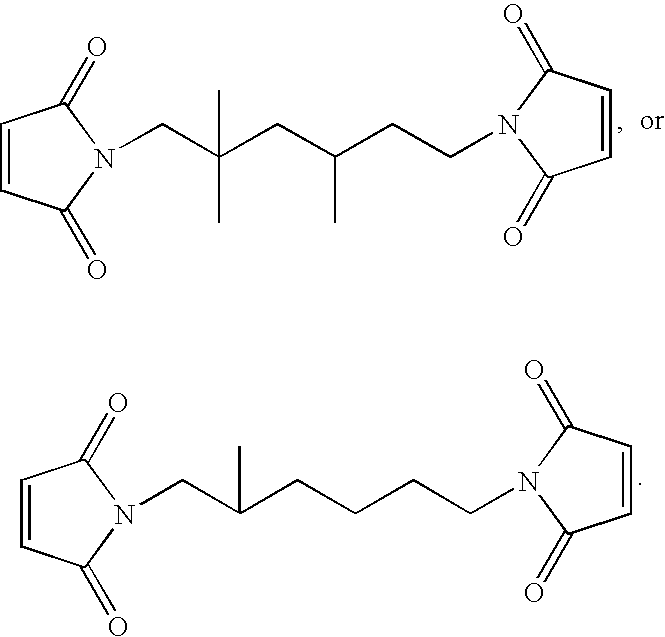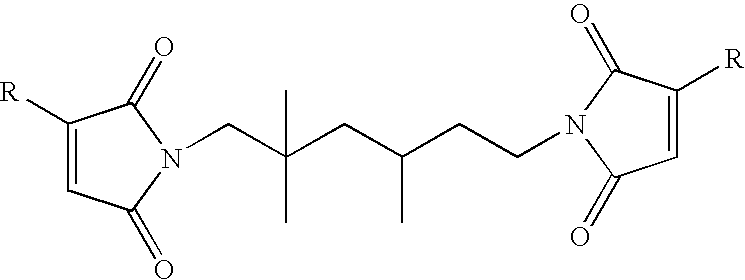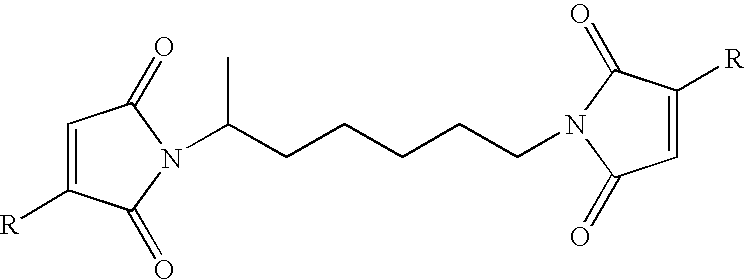Low temperature curing acrylate and maleimide based formulations and methods for use thereof
a technology of acrylate and maleimide, which is applied in the direction of film/foil adhesives, solid-state devices, tyre parts, etc., can solve the problems of cumbersome work of two parts, inconsistent and unreliable two parts, and inapplicability to large-scale manufacturing applications
- Summary
- Abstract
- Description
- Claims
- Application Information
AI Technical Summary
Benefits of technology
Problems solved by technology
Method used
Image
Examples
example 1
Preparation of Compound C-1
[0105]
[0106]A single neck, one liter flask was charged with 60 g methanesulfonic acid, and 300 mL toluene. The flask was then charged with 45 g of anhydrous triethylamine. The mixture was magnetically stirred for five minutes and then 64.8 g (0.66 mole) maleic anhydride was added and the mixture was stirred until all of the anhydride had dissolved. An addition funnel was attached to the flask and 47.49 g (0.30 mole) 2,2,4-trimethyl-1,6-diamine was then dripped in over a twenty minute period. It was noted that the pot had to be kept at a temperature equal to or greater than 50° C. to avoid the precipitation of the bismaleamic acid as it formed. A Dean-Stark trap and condenser were then attached to the flask and the mixture was refluxed for 16.5 hours. A total of 11.0 mL water had been collected (expected 10.8 mL). The mixture was cooled to room temperature and 30 mL of deionized water was added. The upper toluene phase was decanted off and the lower phase w...
example 2
Preparation of Compound C-2
[0107]
[0108]A single neck, one liter flask was charged with 80 g methanesulfonic acid, and 400 mL toluene. The flask was then charged with 64 g of anhydrous triethylamine. The mixture was magnetically stirred for five minutes and then 107.9 g (1.1 mole) maleic anhydride was added and the mixture was stirred until all of the anhydride had dissolved. An addition funnel was attached to the flask and 58.1 g (0.50 mole) 2-methyl-1,5-pentanediamine was then dripped in over a thirty minute period. It was noted that the pot had to be kept at a temperature equal to or greater than 70° C. to avoid the precipitation of the bismaleamic acid as it formed. A Dean-Stark trap and condenser were then attached to the flask and the mixture was refluxed for 63 hours. A total of 16.5 mL water had been collected (expected 18.0 mL). The mixture was cooled to room temperature and 25 mL of deionized water was added. The upper toluene phase was decanted off and the lower phase was ...
example 3
Preparation of Compound C-4 (m=2, n=10)
[0109]
[0110]A 500 mL, single neck flask was charged with 60 mL N-methyl-2-pyrrolidone (NMP) and 30.6 g (0.1 anhydride equivalents) of SMA EF-20 styrene maleic anhydride copolymer (Sartomer Company, Inc., Exton, Pa.). This mixture was warmed and stirred magnetically until a homogeneous solution was obtained. The flask was then charged with 120 mL toluene. An addition funnel was attached to the flask and 20.4 g isophorone diamine dissolved in 60 mL toluene was dripped in over twenty-five minutes. The solution became a milky peach color and the temperature rose to about 40° C. The mixture was stirred for another ten minutes after all of the diamine had been added. The flask was then charged with 5.0 g methanesulfonic acid and then 15.7 g (0.16 mole) maleic anhydride. The flask was equipped with a Dean-Stark trap and condenser, and then heated to reflux. The mix became a clear solution about an hour after the beginning of reflux. Reflux was continu...
PUM
| Property | Measurement | Unit |
|---|---|---|
| temperature | aaaaa | aaaaa |
| temperature | aaaaa | aaaaa |
| temperature | aaaaa | aaaaa |
Abstract
Description
Claims
Application Information
 Login to View More
Login to View More - R&D
- Intellectual Property
- Life Sciences
- Materials
- Tech Scout
- Unparalleled Data Quality
- Higher Quality Content
- 60% Fewer Hallucinations
Browse by: Latest US Patents, China's latest patents, Technical Efficacy Thesaurus, Application Domain, Technology Topic, Popular Technical Reports.
© 2025 PatSnap. All rights reserved.Legal|Privacy policy|Modern Slavery Act Transparency Statement|Sitemap|About US| Contact US: help@patsnap.com



